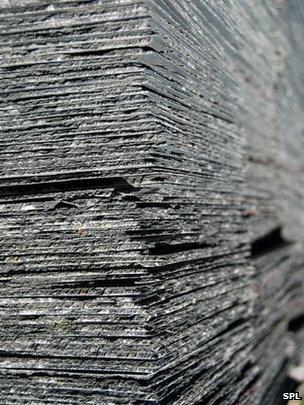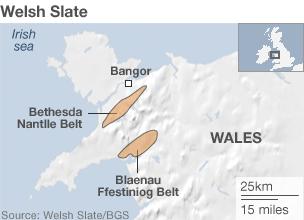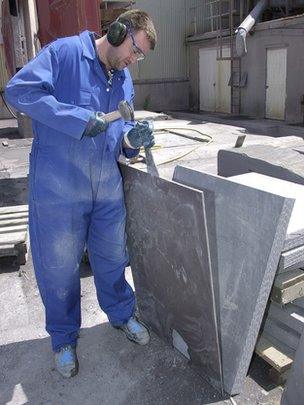Welsh slate: Strong, thin, and long on history
- Published

North Wales is associated with slate in the way South Wales is associated with coal
Slate. It is part of the look and feel of Wales, and now there are efforts to have its iconic status more formally recognised on the international stage.
Experts want it listed as one of the great natural stones to have had an impact on human culture the world over.
Since Roman times, the quality of Welsh slate has made it a premier building material, with top architects still demanding it for prestige projects.
This makes it a candidate for "Global Heritage Stone Resource, external" status.
Other rocks that will be considered are likely to include one or two of those exquisite Italian marbles, such as Carrara, and that other redoubtable British building block - Portland stone.
The case for many is being made in a special session here in Vienna this week at the European Geosciences Union (EGU) General Assembly.
"The story of Welsh slate is one of incredible cultural heritage," said Dr Jana Horak, the head of mineralogy and petrology at the National Museum of Wales, external.
"Roman forts in North Wales were using slates from AD77; it was being exported from medieval times and then the industry really took off during the industrial revolution.
"You can find it now in so many places. Even in Australia today they are replacing original slate roofs with more Welsh slate, to keep that look. It's not just a 'good slate'; it's the best," she told BBC News.
Dr Barry Cooper: “Stone is a very important, sustainable building material”
At its peak, the Welsh slate industry was extracting about 500,000 tonnes of the material each year. Production has now fallen to a tenth of that as cheap, cement-based products have come to dominate the building industry.
But there are still a handful of mines in operation, supplying especially the prestige sector.
Slate is a metamorphic rock - what started out as a mudstone has had its clay mineral make-up altered under conditions of raised pressure and temperature over millions of years.
Grains of platy white mica become aligned perpendicular to the direction of compression.

The thin banding that develops is what allows the skilled craftsman to split the rock into slender sheets.
"Welsh slate is very strong but because of the critical spacing of these white mica zones, it is possible to split it very, very finely," explained Dr Horak.
"That obviously makes for a lighter slate, which is advantageous because you do not then need such a big infrastructure to hold the roof up."
North West Wales is recognised as the region producing the best product. It occurs in two strips that straddle a line running through the Llyn Peninsula.
The original sediments in the Bethesda-Nantlle Belt are Cambrian in age - a little over 500 million years old; the Blaenau Ffestiniog belt is slightly younger (Ordovician). Both experienced their metamorphism during tectonic events in the Silurian Period, about 400 million years ago.

Jonathan Adams' Millennium Centre in Cardiff is a wonderful advert for the variety found in Welsh slate
The colours range from the traditional grey through to purple and green. Diverse textures are evident as well.
To see many of these forms in one place, one only need look up at the façade of the Millennium Centre in Cardiff.
"The architect Jonathan Adams is very stone-aware and went around Wales, picking out examples for their colour and textural variation. He also brought traditional slate workers down from North Wales to supervise the cutting. The Millennium Centre is a wonderful advert for Welsh slate."

Strong but possible to cleave into very thin sheets
But, argues Dr Horak, there are plenty of other fine examples in recent years also, and she cites two US buildings - the Exxon HQ in Texas, and Boston Airport in Massachusetts.
A proposal is already being made to have the Welsh Slate Province (those two slate-bearing bands) designated as a Unesco World Heritage Site.
Getting a Global Heritage Stone Resource designation would be slightly different, although highly complementary.
It is a new award being promoted by international scientific societies that are keen to raise the profile of building stone, and the part it has played in the human tradition.
It would help set definitions and standards to guide architects and conservation bodies. It could also give some measure of protection to traditional industries and supplies, argues Dr Barry Cooper, who holds an adjunct position at the University of South Australia and is a leading light behind the award.
"If a stone was designated as an international heritage resource, people are going to be less likely to want to cover in a quarry and restore the environment because that resource may be needed for the future restoration of old buildings," he told BBC News.
"It's also, for example, about names. If a restoration was taking place it might be possible for a cheaper product to be used - perhaps a cheaper foreign stone - instead of an old-fashioned British or European stone. But by designating it and defining it and giving it a name, architects and builders can very clearly specify the stone they want for a restoration project."
The first Global Heritage Stone Resource designations are likely to be awarded in the next few years.

Wales is still producing slate today but other, cheaper materials, including cement-based products, have come to dominate the market for roofing supplies
Jonathan.Amos-INTERNET@bbc.co.uk and follow me on Twitter: @BBCAmos, external